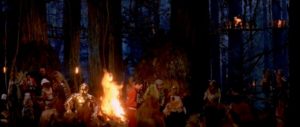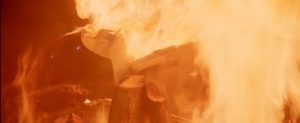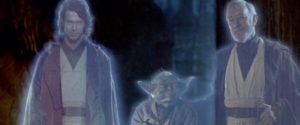Star Wars: Episode VI–The Return of the Jedi (1983). Written by Lawrence Kasdan and George Lucas. Directed by Richard Marquand. Starring Harrison Ford, Carrie Fisher, Mark Hamill, and James Earl Jones. PG. 131 mins. Rotten Tomatoes: 80%.
If the self-sacrificial death and redemption of Darth Vader comes as a surprise in the last moments of the Death Star, that sequence pales in the surprise of what follows. The scene shifts from the exploding Death Star to the victory celebration of the Republic on the moon on Endor. The camera moves from the reunion of the heroes of the battle, all kinds together: Wookie, Ewoks, princesses, warriors of every kind, and Jedi, all dancing and whooping aplenty, as befits victory but, more than that, the coming of abundant palpable hope and love. It is a wondrous conclusion to George Lucas’ long parable, a party as befits the triumph of Love.

Enough, we think, but then we have already seen the funeral pyre of Darth Vader, the camera up close gazing at his remains attired still in helmet and cape, his blackness now consumed and refined by fire, presumably a purifying fire that burns away, literally and figuratively, the darkness that he was.

A stretch, you say? Not really, not by a long shot. For what follows, in the film’s last frames, pulls us up short by the scruff of our souls. Amid the mirth of the party, Luke Skywalker, hero of the day and son to Anakin Skywalker (alias Darth Vader), steps aside for a pensive moment, and in his private vision, he glimpses three shimmering figures. Two we recognize: Jedi Master Yoda and his apprentice, Obi-wan Kenobi (Alec Guinness). The third we have not seen before, at least not in this guise. Viewers saw him briefly not along ago when Luke removed Darth Vader’s black helmet to reveal Anakin Skywalker’s badly maimed face behind a mechanical breathing apparatus of some kind. We glimpse him then only because the dying Anakin Skywalker wanted to see his son Luke “with my own eyes,” at last seeing face to face, instead of through the lenses of his helmet (a dark mirror indeed), which through the length of three films has masked for his real identity, especially from himself. Here again the screenwriters have found a perfect trope conveying the gist of Paul’s counsel on the human fix and its thirst for divine radiance in the coming of Love.
Now, though, after that funeral pyre, to Luke (and us), he looks a new creature, impossibly different from the badly maimed father, for he has been restored, made new, inside and out. And Anakin, like Luke Skywalker’s other two guides, smiles broadly, bestowing on Luke their collective satisfaction and blessing at the Jedi he has become.
Indeed, love has redeemed, renewed, and made whole. And together the three form for Luke, who surely needed much help, a kind of holy trinity, and the restoration of Anakin Skywalker extends the notion of his personal redemptio

n to the full healing of the self. And frankly, there is not a more fulsome and apt rendition of redemption in the popular film of the West. With Luke we see what “the glory of the coming of the Lord” might actually look and how it might feel in one’s own lost and forlorn heart and the soul. The whole reiterates the mood and gist of Shakespeare’s ending to King Lear, the tragic old king pronouncing to his daughter “When thou dost ask me blessing, I’ll kneel down. and ask of thee forgiveness. So we’ll live. And pray, and sing, and tell old tales, and laugh” (Act 5, Scene 3). The last being what Luke does as he turns away.
Sign Up for Our Newsletter!
Insights on preaching and sermon ideas, straight to your inbox. Delivered Weekly!

Categorized into Discipleship, Love, Redemption
Star Wars: Episode VI–The Return of the Jedi (1983) – 1